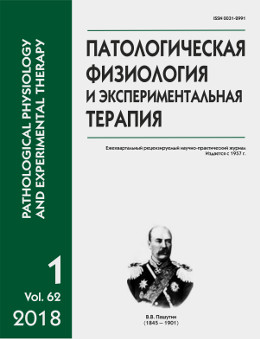Pathological neurogenesis – key link of pelvic pain pathogenesis caused by adenomyosis
DOI:
https://doi.org/10.25557/0031-2991.2018.01.59-64Keywords:
adenomyosis, chronic pelvic pain, pathogenesis, myometrium, neural apparatus, neurofilaments, pathological neurogenesisAbstract
Objective. To study morphological features of myometrium’s neural apparatus in women with chronic pelvic pain syndrome associated with adenomyosis. Methods. 60 biopsies received after hysterectomies due to diffuse adenomyosis of I-III grades and accompanied by severe pelvic pain syndrome were studied. These women didn’t receive any hormonal therapy. Control group included 10 biopsies obtained from women with adenomyosis without pelvic pain syndrome, in which operations were performed because of abnormal uterine bleeding. Also they didn’t receive any hormonal therapy. After hysterectomy ewes wall portions including endometrium and myometrium were fixed in neutral buffered 10% formalin (pH 7.4) for 24 hours. After dehydration, the material embedded in paraffin, highly purified with polymer additives (Richard-Allan Scientific, USA) at a temperature not higher than 60 °C. Overall morphological evaluation of sections was performed at H & E stain. Imaging was performed after nerve fibers immunohistochemical (IHC) staining using monoclonal antibodies (MAbs) to neurofilament proteins (DAKO, Denmark) according to the instructions of the firm. The results. Studying of the uterine innervation apparatus in an adenomyosis using monoclonal antibodies to neurofilament proteins identified by a variety of fiber thickness, density and color intensity. The density of nerve endings, directly conjugated with endometriosis was nevelika¬ - zone glands 4,1 ± 0,3 mm2 per slice in the stroma - 9,2 ± 0,6. Thin nerve fibers were visualized mainly in the stroma around blood vessels that accompany zone ingrowth ectopic endometrium. Dense plexus of thin nerve fibers were also found in the subserous layer. And, as in the subserous and in the submucosal layer of the myometrium prevailed branched thin nerve fibers, the number of which is statistically significant (p <0,01) than those in the comparison group - 17,2 ± 1,4 vs. 11,8 ± 0, 9 per mm2. Comparison of innervation apparatus of the uterus in women with and without chronic pelvic pain syndrome suggests that it is the expansion of the field of innervation in the myometrium is the most likely cause of the formation of pelvic pain in women with adenomyosis. Conclusions. The results of this study have demonstrated the fact that the main carrier of the nerves in the uterus and a potential cause of the formation of hyperalgesia with adenomyosis is myometrium with formation of abnormally excessive innervation apparatus in the myometrium around the endometriotic foci and also in perivascular fields and in an stroma between smooth myocytes fibers.Downloads
Published
2018-01-25
Issue
Section
Original research
How to Cite
[1]
2018. Pathological neurogenesis – key link of pelvic pain pathogenesis caused by adenomyosis. Patologicheskaya Fiziologiya i Eksperimental’naya Terapiya (Pathological physiology and experimental therapy). 62, 1 (Jan. 2018), 59–64. DOI:https://doi.org/10.25557/0031-2991.2018.01.59-64.






